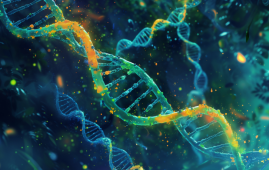

Recent studies have shown that practices like meditation and exposure to art or nature can positively affect brain health and emotional well-being. However, most research has examined these practices separately rather than comparing their effects on brain activity. A new study from the University of California, Los Angeles (UCLA), takes a groundbreaking approach by comparing the brain activation patterns triggered by transcendental meditation, nature videos, and digital art, offering a new perspective on their impact on mental health.
Published in Frontiers in Human Neuroscience, the study analyzed how these three experiences—meditation, nature, and digital art – influence brain activity. The team recruited nine healthy adults with low stress and anxiety, exposing them to various video stimuli inside an fMRI scanner. Participants practiced transcendental meditation while viewing star nebula videos, watched nature videos of national parks, and viewed digital art created by renowned artist Refik Anadol.
Dr. Helen Lavretsky, the study’s senior author, noted that the brain regions activated by each type of experience were distinct. Meditation led to increased blood oxygen-level dependent (BOLD) responses in areas associated with sensory, memory, and object processing. These effects were notably different from the responses to nature and digital art videos.
Compared to rest, meditation activated the bilateral occipital and fusiform gyri, along with the hippocampus. When compared to nature or digital art, meditation triggered different regions, including the left parietal operculum and bilateral postcentral gyri, revealing how each activity uniquely impacts brain function. Notably, the brain activity related to meditation was linked to memory, sensory integration, and error monitoring.
The research team hopes that their findings will inspire further studies into the potential of meditation, nature, and art to reduce stress and improve mental health. Future studies may deepen our understanding of how contemplative practices can promote well-being and serve as therapeutic tools in clinical applications.
Dr. Lavretsky and her team plan to continue exploring the role of spiritual neuroscience and neuroesthetics in the brain’s response to transcendence and stress relief.
More Information: Beatrix Krause-Sorio et al, Your brain on art, nature, and meditation: a pilot neuroimaging study, Frontiers in Human Neuroscience (2025). DOI: 10.3389/fnhum.2024.1440177
more recommended stories
 Phage Therapy Study Reveals RNA-Based Infection Control
Phage Therapy Study Reveals RNA-Based Infection ControlKey Takeaways (Quick Summary) Researchers uncovered.
 Pelvic Floor Disorders: Treatable Yet Often Ignored
Pelvic Floor Disorders: Treatable Yet Often IgnoredKey Takeaways (Quick Summary) Pelvic floor.
 Urine-Based microRNA Aging Clock Predicts Biological Age
Urine-Based microRNA Aging Clock Predicts Biological AgeKey Takeaways (Quick Summary) Researchers developed.
 Circadian Control of Neutrophils in Myocardial Infarction
Circadian Control of Neutrophils in Myocardial InfarctionKey Takeaways for HCPs Neutrophil activity.
 E-Cigarette Use and Heart Attack Risk in Former Smokers
E-Cigarette Use and Heart Attack Risk in Former SmokersKey Takeaways for Clinicians and Nurses.
 Ultramarathon Physiology: What HCPs Should Know?
Ultramarathon Physiology: What HCPs Should Know?Ultramarathon Metabolism: What Happens to the.
 High-Intensity Training and Oxidative Stress Insights
High-Intensity Training and Oxidative Stress InsightsNew Evidence Linking High-Intensity Training and.
 Sterilized Fermented Beverage for Obesity: New Evidence
Sterilized Fermented Beverage for Obesity: New EvidenceEarly Insights Into a Sterilized Fermented.
 36-Week Pre-eclampsia Screening May Reduce Term Risk
36-Week Pre-eclampsia Screening May Reduce Term RiskA New Preventive Strategy for Term.
 Cardiovascular Risk and Sudden Cardiac Death in Diabetes
Cardiovascular Risk and Sudden Cardiac Death in DiabetesRising Sudden Cardiac Death (SCD) Risk.

Leave a Comment